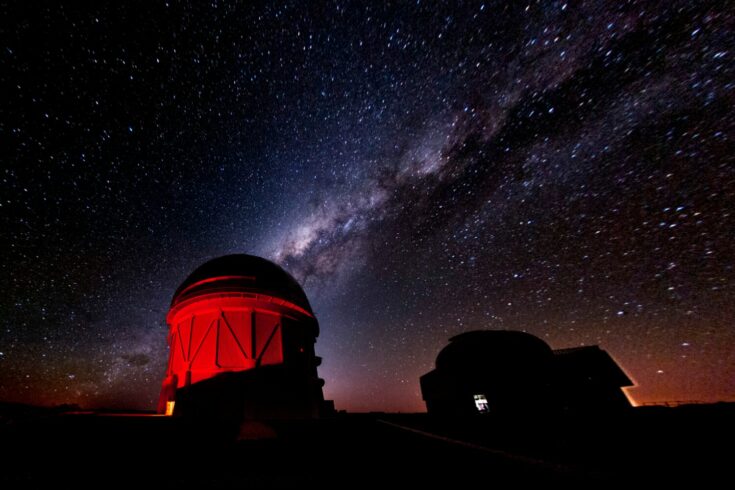The largest-ever map of dark matter, the mysterious invisible substance thought to account for most of the mass of the universe, has been created.
An international team of scientists, co-led by a Science and Technology Facilities Council (STFC) funded UK team, created the map as part of the Dark Energy Survey (DES).
The international project aims to measure the composition of the universe and to better understand dark matter and dark energy, which is thought to be driving the universe’s accelerating expansion.
Mapping matter
One way to investigate this is by studying light that has travelled to Earth from distant galaxies. If the light has been distorted, it suggests there is matter in the way, bending the light as it comes towards us. Astronomers are mapping these distortions which may suggest invisible, but gravitating, mass.
The team used an international supercomputer to analyse images of 100 million galaxies, looking at their shape to see if the light had been stretched.
Co-lead author Dr Niall Jeffrey, of École Normale Supérieure, Paris and University College London (UCL), said:
In our map, we see a similar pattern as we do with visible matter – a web-like structure with dense clumps of matter separated by large empty voids.
Observing these cosmic-scale structures can help us to answer fundamental questions about the universe.
The new map covers a quarter of the sky of the southern hemisphere.
Photographing the night sky
The map was created as part of the DES collaboration, hosted by the US Department of Energy’s Fermi National Accelerator Laboratory (Fermilab) and involving more than 400 scientists from 25 institutions in seven nations. The collaboration has catalogued hundreds of millions of galaxies over six years, from 2013 to 2019.
In the UK the study is funded by STFC.
Professor Grahame Blair, Executive Director of Programmes for STFC, said:
The DES Collaboration is a perfect example of using international collaboration to tackle fundamental questions, and enhance our understanding of the origins and evolution of the universe.
The UK has played a significant role to this exciting scientific endeavour, in contributing cutting-edge technology to enable the ‘eyes’ of the survey and in the exploitation of the data.
Light and dark
Scientists at UCL, with funding from STFC, provided precision optics systems for the 570-megapixel dark energy camera which has been used to survey the dark sky.
The camera is mounted on the Blanco telescope at the National Science Foundation’s Cerro Tololo Inter-American Observatory in Chile.
STFC-funded co-author Professor Ofer Lahav of UCL, chair of the DES:UK consortium, said:
Visible galaxies form in the densest regions of dark matter. When we look at the night sky, we see the galaxy’s light but not the surrounding dark matter – like looking at the lights of a city at night.
By calculating how gravity distorts light, a technique known as gravitational lensing, we get the whole picture – both visible and invisible matter. This brings us closer to understanding what the universe is made of and how it has evolved. It also shows the power of artificial intelligence methods to analyse one of the largest data sets in astronomy.
DES:UK involves scientists from:
- Cambridge
- Edinburgh
- Manchester
- Nottingham
- Portsmouth
- Southampton
- Sussex
- UCL.
The standard cosmological model
Scientists in the DES Collaboration have carried out new analysis of the first three years of the survey.
The analysis suggests that matter is distributed throughout the universe in a way that is consistent with predictions in the standard cosmological model. This is the best current theory of the how the universe was created and what it is made of.
But the analysis found hints, as with previous surveys, that the universe may be a few per cent ‘smoother’ than predicted, with fewer ‘clumps’ of matter.
Exploring 7 billion light years of space with the Dark Energy Survey
Video credit: Fermilab
An autogenerated video transcript is available on YouTube.
Further information
The Dark Energy Survey, which finished its run in 2019, is considered a precursor to the Dark Energy Spectroscopic Instrument (DESI).
DESI is operated by the Lawrence Berkley National Laboratory in the US and also receives STFC-funded support from the UK.
Observations started earlier this month.

